
Feature Article
Phytohaemagglutinin Poisoning
Minimising Health Risks of Oyster Consumption in Snack Food
Oysters are filter feeders and susceptible to contamination from pathogens and chemicals, posing potential food safety risks. Consuming contaminated oysters can lead to food poisoning and health problems. This article highlights the health hazards of oyster consumption and surveillance conducted locally to monitor these hazards, and provides advice on how to reduce food safety risks from oyster consumption.
Hazards of Oyster Consumption
- Chemical Contaminants
As oysters constantly filter seawater, metallic contaminants, such as cadmium, lead and mercury, from the environment will accumulate in oysters, particularly in their internal organs and digestive tracts. Various industrial activities can lead to the discharge of metallic contaminants into the sea, which may in turn contaminate the oyster harvesting areas nearby. Prolonged consumption of oysters containing excessive cadmium and lead can be harmful to kidneys and neurodevelopment. - Pathogens
As oysters are usually cultivated in coastal waters, they can be contaminated with microorganisms and pathogens in seawater, which can result in food poisoning. Such microorganisms and pathogens include bacteria like Vibrio parahaemolyticus and Vibrio vulnificus, parasites like Giardia lamblia and Cryptosporidium parvum, as well as viruses like norovirus and hepatitis A virus. Vibrio bacteria are naturally present in coastal waters, whereas norovirus, hepatitis A virus and some parasites mainly originate from human faecal contamination. - Antimicrobial-resistant (AMR) microorganisms
Eating raw or undercooked oysters will pose a higher risk of AMR microorganism infection. Whether or not these AMR microorganisms have caused illnesses, they may transfer their AMR genes to other bacteria inside human bodies, reducing the efficacy of antibiotics in future.
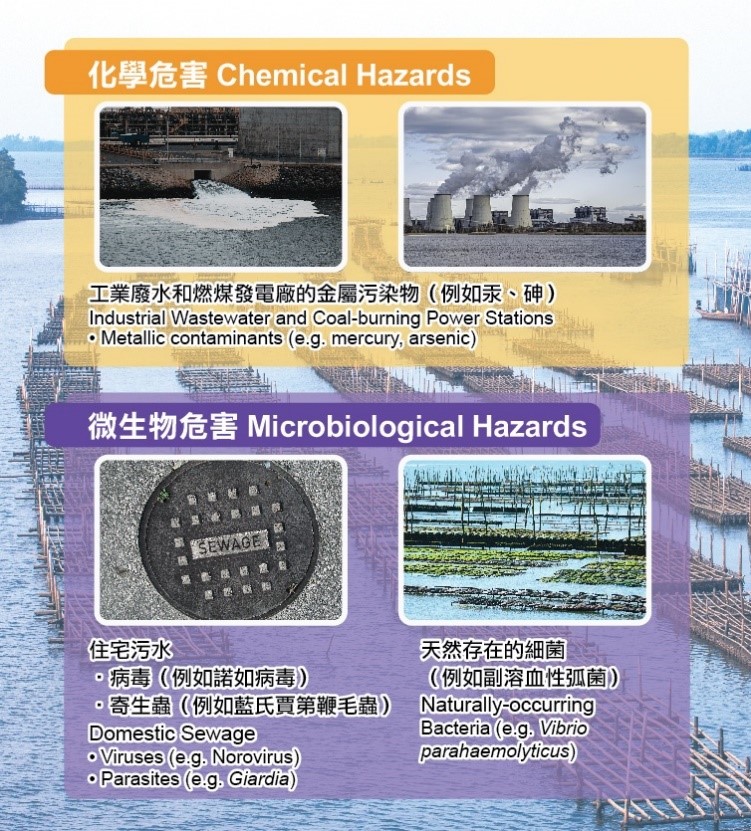
Hazards of oysters and possible sources of contamination
Food Surveillance of Oyster Samples
Oysters and related products have been included in the sampling scope of the Food Surveillance Programme of the Centre for Food Safety (CFS). The CFS collects samples at the import, wholesale and retail levels for chemical and microbiological testing to ensure food safety. Recent surveillance findings revealed that, besides one imported raw oyster sample detected with an excessive level of Escherichia coli, the test results of the rest were satisfactory. As the season of oyster consumption approaches, the CFS has stepped up its testing on oyster samples with a view to safeguarding public health. In a recent seasonal food surveillance project, the test results for metallic contaminants in all oyster samples were satisfactory.
How to Reduce Food Safety Risks when Consuming Oysters?
Oysters inherently carry food safety risks regardless of the season or waters of harvesting. To date, no technology can guarantee oysters are completely free of hazards. Maintaining a balanced diet and refraining from overindulgence in oysters can reduce the risk of exposure to excessive metallic contaminants.
To minimise the microbiological hazards, it is desirable to observe the Five Keys to Food Safety when handling oysters. Choose oysters that are fresh, with intact shells and without abnormal odour. Check the expiry dates of prepackaged shucked oysters before purchase. Chilled and frozen oysters should be properly stored at or below 4℃ and ‑18℃ respectively, and the duration of exposure of raw oysters to room temperature should be minimised. Wash hands thoroughly and put on protective gloves before handling oysters. Use different cutting boards and utensils to handle raw oysters and cooked/read-to-eat food separately to avoid contamination. Only serve shucked raw oysters in small portions each time. Once shucked, oysters must be refrigerated at 4℃ or below immediately, protected from contamination and consumed within one day. Oysters not intended for raw consumption must be thoroughly cooked to minimise the risk of food poisoning.
When handling oysters, a number of procedures like rinsing and shucking are often performed at room temperature. Such procedures should not last more than one hour. Before serving, oysters should not be left at room temperature for longer than two hours cumulatively.

Handling of oysters exposed to room temperature for different durations
Key Points to Note
- Oysters may cause chemical and microbiological hazards.
- The CFS conducts food surveillance of oysters and related products.
- Observing the Five Keys to Food Safety can reduce the food safety risks of oyster consumption.
Advice to the Trade
- Collect oysters from reliable sources with health certificates issued by relevant authorities of the exporting countries or regions.
- Obtain permission in writing/endorsement from the Food and Environmental Hygiene Department before selling raw oysters.
- Source oysters that are harvested from areas of clean waters.
Mascot ON in Lesson
Bongkrekic Acid: Uncommon but Fatal Toxin in Certain Food
In late March 2024, Taiwan’s health authority reported a food poisoning outbreak at a restaurant in Taipei, resulting in 34 cases of illness and two fatalities. Clinical specimens of 33 individuals were tested positive for the toxin bongkrekic acid. It was reported that a chef’s hands were tested positive for the toxin, suggesting that the food handled by the chef might have been contaminated. Suspected incriminated food included flat rice noodles and Char Kway Teow. This article sheds light on this fatal toxin and how to reduce the risk.
What is Bongkrekic Acid?
Bongkrekic acid is a heat-stable toxin produced by the bacterium Burkholderia gladioli pathovar cocovenenans (B. cocovenenans), which is ubiquitous in soil and plants. The temperature range for bacterial growth is between 30ºC and 37ºC and that for toxin production is between 22ºC and 30ºC. Cases of bongkrekic acid poisoning were originally reported among people who had consumed fermented corn and coconut-based products. Certain fatty acids, particularly those found in coconut and corn, can facilitate the growth of the bacteria and the production of the toxin.
Target organs of the toxin mainly include the liver, brain and kidneys, causing such symptoms as a lack of energy, dizziness, drowsiness, abdominal pain and vomiting. The incubation period for the illness is reported to be between 30 minutes and 20 hours. In severe cases, death can occur within 1 to 20 hours after the onset of symptoms. According to the review of national surveillance conducted in the Mainland, previous outbreaks have resulted in a high mortality rate of up to 60%.
Food Items with Emerging Risk?
In recent years, outbreaks of bongkrekic acid poisoning due to consumption of certain soaked mushrooms and wet rice noodles have been reported in Guangdong and Zhejiang. The mushrooms implicated in these outbreaks were silver ear fungus (snow fungus) and black fungus, with more cases involving the latter. Typically, the mushrooms in these outbreaks were found to have been soaked for more than two days, while it was generally believed that bongkrekic acid would have unlikely been formed if these mushrooms had been soaked for only a short period of time under normal conditions.
Wet starch products or wet rice noodle products (using rice as the main raw material) have been another type of food linked to outbreaks in the past few years. Similarly, the main cause of toxin production was believed to be prolonged storage (longer than 24 hours specifically) at room temperature. In certain instances, the illegal use of a preservative called sodium dehydroacetate was uncovered. This preservative can inhibit the growth of some fungi and spoilage bacteria but not B. cocovenenans, resulting in a potential risk of bacterial growth without sensory changes when the noodles are spoiled.

Flat rice noodles and black fungus
Good Hygiene Practices for Prevention
Bongkrekic acid is produced in certain high-risk food items when they are left at room temperature for an extended period of time, typically more than a day. For prevention, it is important to maintain time and temperature control of these high-risk food items, even before cooking. For silver ear fungus or black fungus, they should be soaked under refrigeration if overnight soaking is necessary. For wet rice noodle products whose shelf life is more than one day, they should be kept at refrigeration temperature during transportation, storage and sale. This becomes particularly important during warmer months when the temperature is favourable for the growth of B. cocovenenans. Additionally, to minimise the risk of contamination with microorganisms, it is crucial to practise good food hygiene at all times.
Key Points to Note
-
Bongkrekic acid, a heat-stable toxin produced by the bacterium B. cocovenenans, was originally reported among people who had consumed fermented corn and coconut-based products. Consumption of these products has been associated with outbreaks that have a high fatality rate.
- Outbreaks due to consumption of black fungus and wet rice noodles have been reported in the past few years, typically caused by these food items being left under ambient condition for more than a day.
- To protect against this uncommon but fatal toxin, apart from observing good food hygiene, it is important to maintain time and temperature control of the high-risk food items, even before cooking, to minimise the growth of B. cocovenenans that may be present due to contamination.
Advice to the Trade
-
Wet rice noodles or similar products, especially those that are loosely packed, are recommended to be consumed on the day of purchase or stored under refrigeration.
-
Any leftover wet rice noodles or similar food items from a meal should be refrigerated as soon as possible or discarded.
-
Discard wet rice noodles or similar products and soaked mushrooms that smell or taste abnormal.
Dining Out
Hot Tips for Safe Hot Pot
Hot pot is a popular choice for meals, especially when the weather is cold. It is also suitable for social gatherings at home, where sliced meat, seafood, vegetables and noodles are boiled in a pot of water, soup or congee set on the dining table, and consumed after dipping in condiments amid lively conversations. In this article, we will share some tips for a safe and healthy hot pot meal.

Hot pot is a popular choice for dining at home, especially with a group of people
Be Smart and Use “5 Keys to Food Safety” When Preparing Hot Pot
Choose:
Purchase hot pot ingredients from reputable, licensed retailers. Make sure that the ingredients are fresh and in good condition. For prepackaged food, ensure the packages are intact and the products are still within the use-by date.
Clean:
Maintain good personal, food, and environmental hygiene throughout preparation. Before handling food, before eating, after touching raw meat or seafood, and before touching ready-to-eat food, wash hands properly with liquid soap for at least 20 seconds. Utensils and food contact surfaces should be cleansed regularly. When washing vegetables, rinse them thoroughly under running water. When preparing shellfishes and bivalves, scrub and wash the outer shells with water to remove dirt. Soak live bivalves in water for half a day to reduce the amount of sand and microorganisms. Remove the intestines and gonads from scallops to reduce the risk of contaminants. Be careful when washing raw meat and poultry to avoid contamination by pathogens through splashes. Clean and disinfect the sink and its surroundings afterwards.
Separate:
During a hot pot meal, raw and cooked ingredients are often put close to each other for convenience, which will increase the chance of pathogens from the raw ingredients contaminating the cooked food and also the risk of cross-contamination. Use different sets of chopsticks and utensils to handle raw and cooked food separately. Avoid putting too many dishes on the table to minimise food-to-food cross-contamination.
Cook:
Inadequate cooking is a major food safety risk in a hot pot. Raw food may harbour harmful bacteria and viruses which may survive if the food is undercooked. It can subsequently cause food poisoning after consumption. Whenever water or soup is added, food should only be picked up after the soup has come to a full boil. Refrain from overfilling the pot to prevent uneven cooking. Care should be taken to ensure that larger pieces of food are thoroughly cooked to a core temperature of at least 75°C before consumption. Oysters and shellfish should be heated to a more stringent requirement of an internal temperature of 90°C for 90 seconds, or boiled at 100°C until their shells are open and continue for another three to five minutes to ensure the inactivation of common foodborne viruses like hepatitis A and Norovirus. Thorough cooking can destroy common pathogenic bacteria like Salmonella spp., Vibrio parahaemolyticus and Listeria monocytogenes, or viruses like Norovirus and hepatitis A that may be present in hot pot ingredients.
Safe Temperature:
After bringing the hot pot ingredients home, store them properly. Keep frozen products in a freezer at -18°C or below and chilled products in a refrigerator’s chiller compartment at 4°C or below. Do not defrost food at room temperature. Defrost properly, preferably in a chiller overnight, or under cold running water or in a microwave. Cook the defrosted food instantly and do not re-freeze it if the latter two defrosting methods have been used. Some small frozen items like dumplings and fish balls can be boiled directly from a frozen state and defrosting is not necessary.
Other Noteworthy Issues
Avoid consuming raw eggs or using them as a dip, due to the Salmonella risk. Use pasteurised shell eggs instead. Also, condiments like wasabi or strong wine used in marinating raw seafood cannot kill the bacteria or parasites present. Only foods intended for raw consumption can be eaten raw. Choose soup bases with lower fat and sodium content like plain water or a clear broth. Maintain a balanced diet by including more vegetables as part of the hot pot meal and avoiding overindulgence in high-salt (sodium) and/or high-fat food like fish balls, beef balls, imitation crab sticks, sausages, instant noodles, fatty meat, offal and bones, sacha and mala soup bases, etc. Use condiments like soy sauce sparingly. Do not consume foods that are still scalding hot. Bon Appetit!
Healthy Eating Basics and Smart Food Choices
Healthy Eating Basics
How to Interpret the Test Report on Instant Noodles
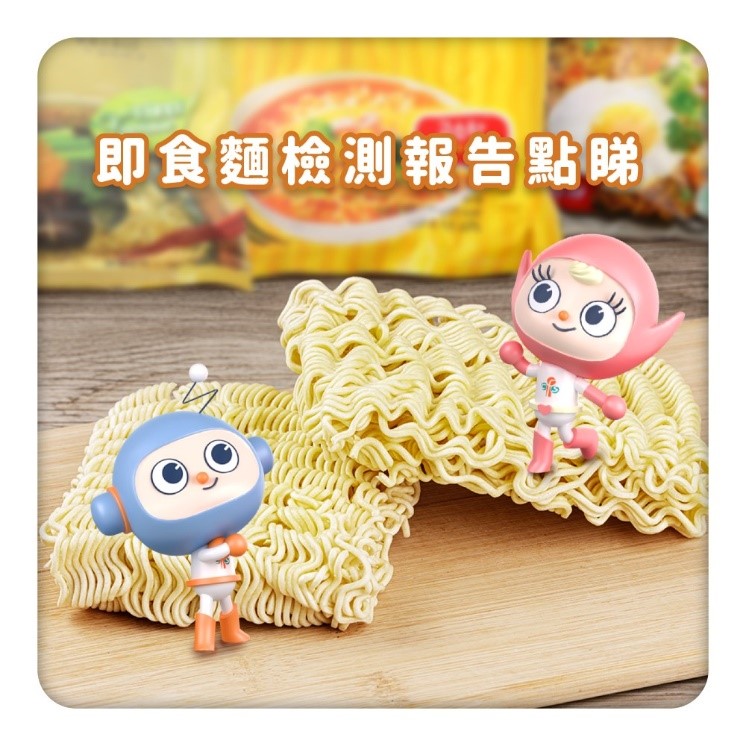
When you are hungry, would you like someone to cook you a bowl of noodles? Given that instant noodles are a must-have food in many households, of course they have to be chosen and eaten wisely. An organisation collected a total of 19 samples of instant noodles on the market for chemical and nutrient content tests.
Listen to Our Mascots:
Glycidyl Ester (GE) & 3-monochloropropane-1,2-diol Ester (3-MCPDE)
- GE and 3-MCPDE are substances produced during high-temperature processing. They may be found in food that contains fats and oils and has been processed at a high temperature.
- At present, no maximum levels have been set for GE and 3-MCPDE in instant noodles by the Codex Alimentarius Commission (Codex) or internationally. Nevertheless, Codex has developed a Code of Practice to help the trade reduce the levels of these two substances in food.
- The CFS has always been concerned about the issue of GE and 3-MCPDE in food, and has put in place various risk management measures, including conducting risk assessment studies and promoting Codex’s Code of Practice among the food trade.
- The CFS also holds briefings from time to time to explain to the trade the Code of Practice to facilitate the trade in providing better products to the public. It will continue to maintain close communication with the trade so as to lower the levels of GE and 3-MCPDE in refined oil and its food products by, for example, choosing raw materials with lower levels of GE and 3-MCPDE and using less oil in food production. The response from the trade has been positive.
- In 2020, the CFS conducted a study on GEs in local edible fats and oils, as well as infant formula available in the local market. It was found that the GE levels in the samples collected locally were on a par with those in similar products in Europe, New Zealand and Australia.
Plasticisers
- Currently, Codex has not set any standards concerning the levels of plasticisers in food. The levels of plasticisers detected in the samples by the organisation mentioned at the beginning of this article did not exceed the action levels adopted by the CFS and met statutory requirements.
Follow-up Action
-
The CFS has taken follow-up action against all the cases referred by the above organisation. In addition to 24 follow-up samples, 12 instant noodle samples were collected from the retail market for testing, of which one prepackaged instant noodle sample was found to be non-compliant with nutrition labelling requirements. The CFS has published the test results and instructed the vendor concerned to stop selling the affected batch of products. Prosecution will be instituted if there is sufficient evidence.
-
As for risk communication, a briefing was held in January 2024 to brief the trade on the Code of Practice. Members of the trade were encouraged to choose raw materials with lower levels of GE and 3-MCPDE and use less oil in food production. The CFS has briefed the trade on the contents of the above briefing at the Trade Consultation Forum held in March 2024 and disseminated the relevant information on the CFS’s social media page.
Food Surveillance
- From 2020 to 2023, the CFS collected a total of about 390 instant noodle samples for chemical (including 3-MCPDE and nutrient content) and microbiological testing. Except for three sample whose pesticide content and one sample whose nutrient content were found to be non-compliant with the relevant regulations, all the remaining samples passed the tests. The CFS has published and followed up on the results.
Food Safety Reminders:
-
Members of the public should read the nutrition labels carefully and choose noodle products with lower fat and sodium content.
-
Sauces is one of our major dietary sources of sodium. When consuming instant noodles, do not add all the seasoning and avoid drinking the soup as far as possible.
-
Maintain a balanced diet, reduce the consumption of processed food that is rich in fats and oils as far as possible, and avoid the risk of increased intake of GE and 3-MCPDE due to picky eating.
Smart Food Choices
Mexican Roll with Lemon and Apricot Sauce
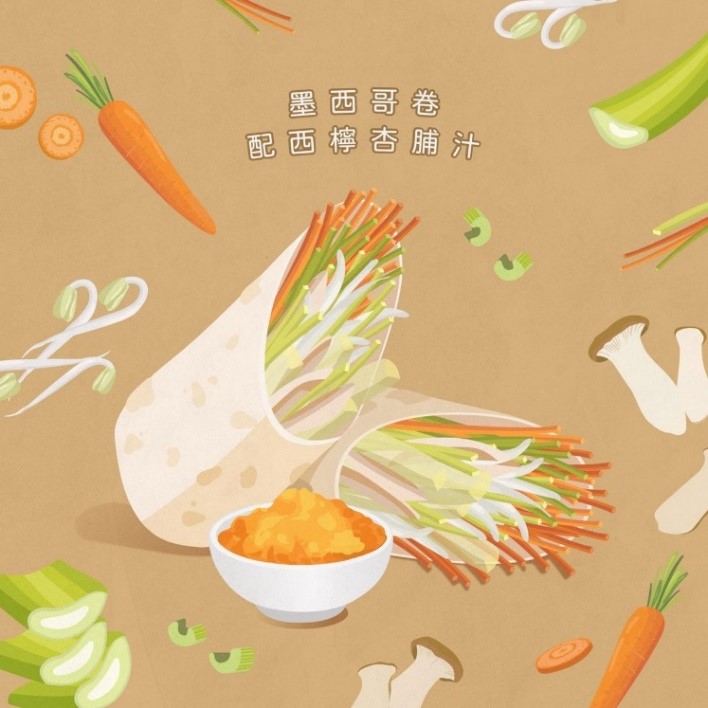
For many people, when it comes to Mexican delicacies, Mexican roll immediately comes to mind. Made with high-fibre vegetable fillings and served with homemade lemon and apricot sauce, the roll is a “3 low” choice that is both tasty and healthy!
Please visit the following page for the recipe:
https://restaurant.eatsmart.gov.hk/eng/content.aspx?content_id=447

News on CFS
- CFS’s Talk on Recommendations on Preventing Food Complaints
Food complaints not only seriously damage a restaurant’s reputation but may also lead to suspension or cancellation of its licence. In view of the rising trend of food complaints in the past few years, the CFS specially held a talk on recommendations on preventing food complaints for the trade on 8 May to shed light on how to reduce food complaints through “Good Hygiene Practices” (GHPs) and “Hazard Analysis and Critical Control Point” when handling food.
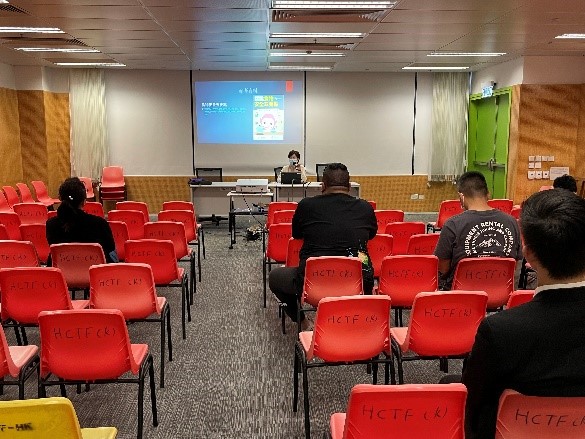
- The 85th Meeting of the Trade Consultation Forum
The 85th meeting of the Trade Consultation Forum was held on 21 June. The CFS and the trade exchanged their views on various topics including “Safe handling of rice and noodles to prevent food poisoning, including Bongkrekic acid poisoning”, “Food safety guidelines for food business on preparation of salads”, “Advance release arrangement for Hong Kong-manufactured food products entering the Mainland Market”, “Extension of operational hours for fresh produce imported via Hong Kong-Zhuhai-Macao Bridge”, and “The Guangdong-Hong Kong-Macao Greater Bay Area Food Standards”. For details of the event, please visit:
https://www.cfs.gov.hk/english/committee/Notes_and_Presentation_Materials_TCF85_20240621.html

- CFS’s Webinars on “Safe Food at School” and “Food Safety of Student Lunch Boxes” for 2024/25 School Year
The CFS strives to ensure food safety at school by conducting yearly and territory-wide inspections of licensed food factories supplying lunch boxes for schools and organising trade talks to remind lunch box suppliers to adhere to GHPs when preparing food. With the approach of the 2024/25 school year, the CFS held webinars on “Safe Food at School” and “Food Safety of Student Lunch Boxes” on 5 and 11 July for school staff and student lunch box suppliers respectively. They covered the safety issues of lunch boxes, high-risk foods, the risk of choking and food allergies, etc. Suppliers were also reminded to follow basic food hygiene/safety principles and ensure that staff members observe good personal and environmental hygiene.


Ask Our Mascots
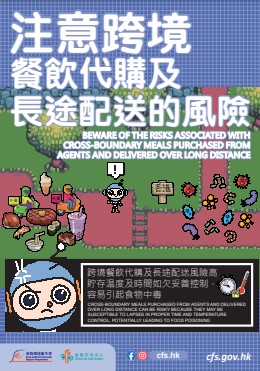
Beware of the Risks Associated with Cross-boundary Meals Purchased from Agents and Delivered over Long Distance
The CFS reminds members of the public to be cautious and pay attention to the delivery time and temperature control of food when ordering cross-boundary meals delivered by agents.
Risks Associated with Cross-boundary Meals Purchased from and Delivered by Agents
Meals need to be delivered over a long distance will be prone to spoilage during the delivery process if there is no proper control on the food storage temperature and delivery time.
Most pathogenic bacteria multiply rapidly at the temperature danger zone (i.e. between 4°C and 60°C). To ensure the food safety of delivered meals, hot food and cold food should be kept at above 60°C and at or below 4°C respectively during the delivery process. If food is kept within the temperature danger zone, the two-hour and four-hour principle should be followed (i.e. if prepared food is kept at room temperature for less than two hours, it can be refrigerated for later use; if cooked food has been held at room temperature for more than four hours, it should be discarded).
Members of the public should order delivered meals from reputable online shops and pay attention to the types of food and the potential risks of food safety. For more advice on the safety of purchasing food online, members of the public could visit this webpage (cfs.gov.hk/onlinefood).
Do Not Bring Game, Meat, Poultry or Eggs without a Health Certificate into Hong Kong
According to the Imported Game, Meat, Poultry and Eggs Regulations (Cap. 132AK), it is an offence to bring game, meat, poultry and eggs into Hong Kong without a health certificate issued by an issuing entity of the place of origin and/or prior permission in writing from the Food and Environmental Health Department. Upon conviction, an offender shall be liable to a fine of HK$50,000 and imprisonment for six months.
Relevant leaflet:

Food Safety Quiz
1. At what temperatures should chilled and frozen oysters be stored respectively?
- 6℃ and -16℃ or below
- 4℃ and -18℃ or below
- 8℃ and -18℃ or below
- 4℃ and -10℃ or below
2. What is “high sodium food”?
- food with over 200mg of sodium per 100g of food
- food with over 400mg of sodium per 100g of food
-
food with over 600mg of sodium per 100g of food
-
food with over 800mg of sodium per 100g of food
3. Which of the following is not one of the “Five Keys to Food Safety”?
-
Choose safe raw materials
-
Separate raw and cooked food
-
Cook thoroughly
-
Critical limits

Diary of Mascot ON
Don't Pick and Eat Wild Food
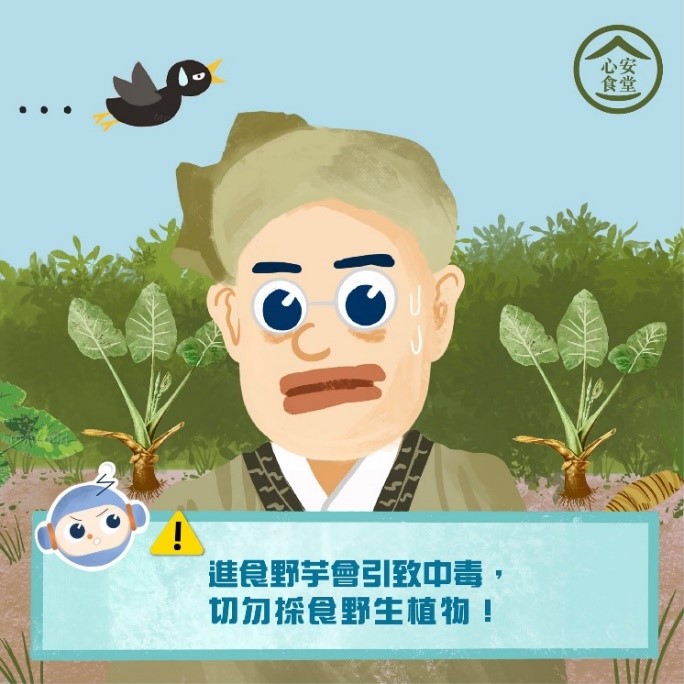
Many of my friends love to eat taros. Some even plan to make their own taro cakes for the coming Chinese New Year. However, don’t confuse the wild taros we see while hiking with taros. Never pick and eat wild taros! Although both wild taros (also known as giant alocasias) and taros have large, obcordate leaves, the leaves and roots of the former contain a substantial amount of calcium oxalates crystals, which can lead to poisoning after consumption. People who have eaten wild taros will suffer irritation in the oral cavity, numbness of the tongue and swollen lips. However, the instantaneous pain and swelling of the oral cavity usually stop the person affected from further ingesting the plant immediately.
What is more, the humid environment in spring is favourable to the growth of wild mushrooms. When you see wild mushrooms in the countryside, remember to restrain yourself from picking them for consumption. Some poisonous mushrooms look so similar to non-poisonous ones that only an expert can tell them apart. In the past, there were occasional reports of poisoning involving members of the public who had eaten wild mushrooms picked by themselves. The consequences of eating by accident mushrooms that contain mushroom toxins can be very serious, such as causing permanent damage to the organs or even death.
Don’t think that it is safe to eat wild taros and wild mushrooms that are cooked, for cooking cannot remove the toxins from wild plants. Let me give you a number of tips:
- Do not pick and eat wild plants like wild mushrooms and wild taros.
-
Purchase vegetables from reliable suppliers.
-
Remove any unidentified plants and objects mixed with vegetables before cooking.
-
Seek medical attention immediately if you feel ill after eating.





